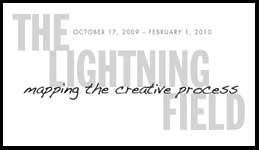

 OCTOBER 17, 2009 – FEBRUARY 1, 2010
OCTOBER 17, 2009 – FEBRUARY 1, 2010
THE LIGHTNING FIELD:
MAPPING THE CREATIVE PROCESS
SOUTHWESTERN WRITERS COLLECTION
We can never see the flashes of inspiration that strike writers, but at the Wittliff Collections we can map the impressions from such moments as they are seared into the archival record.
An odd scrap of paper can hold the key to a classic novel, a journal entry can spark a story, or a letter sent to a friend can lead a writer down an entirely new path. Most often, however, writers conjure up inspiration the old-fashioned way: by extensive rewriting and revision. Even Jack Kerouac’s On the Road wasn’t completed on a long scroll of paper, as legend has it. Kerouac, like all writers, painstakingly reworked his material, understanding that only intense rewriting could lead him closer to his creative vision.
As Mark Twain noted, “the difference between the almost right word and the right word is the difference between the lightning bug and the lightning.” The leading writers of the Southwest make it their business to be lightning rods, and the new exhibit at the Wittliff Collections, The Lightning Field: Mapping the Creative Process, utilizes journals, letters, and manuscripts to illuminate the how of creation.
Among the examples visitors will see are the progressive versions of “Falling Without End,” a short story composed by Sam Shepard. The story began as a handwritten journal entry in February 1990, and Shepard’s sharp-eyed revisions—documented in his archive at the Wittliff Collections— gradually brought the story into clearer focus until it was published in his 1996 collection, Cruising Paradise.
Also on view are the different drafts of James Crumley’s first page of The Last Good Kiss, his novel that contains one of the most celebrated opening sentences in American literature: “When I finally caught up with Abraham Trahearne, he was drinking beer with an alcoholic bulldog named Fireball Roberts in a ramshackle joint just outside of Sonoma, California, drinking the heart right out of a fine spring afternoon.” Crumley claimed that it took him eight years to write the line, and the manuscript drafts show the ways he painstakingly worked over the words.
Also on display are vital documents from the archives of Robert Benton, Sarah Bird, Gary Cartwright, Elizabeth Crook, J. Frank Dobie, Robert Flynn, Jovita González, John Graves, Stephen Harrigan, William Hauptman, Shelby Hearon, Jim Hightower, Molly Ivins, Preston Jones, King of the Hill, Beverly Lowry, Cormac McCarthy, Larry McMurtry, Angela Shelf Medearis, Celia Morris, Katherine Anne Porter, Ron Querry, Ben Rehder, Jan Reid, Rick Riordan, Bud Shrake, Texas Monthly, Tino Villanueva, and Bill Wittliff.
The Lightning Field is presented in conjunction with Texas State’s 2009-2010 Common Experience text, Daniel Pink’s A Whole New Mind: Why Right-Brainers Will Rule the Future. The Common Experience brings students together to read and engage with a single text. A Whole New Mind examines the creative abilities individuals and organizations must master to succeed in today’s world.
An interactive exhibit quiz for The Lightning Field accompanies the display, offering nourishment and exploration for those who wish to continue the journey.
For more on the Texas State Common Experience and the 2010 theme, “The Whole Mind: Crossing Boundaries of Disciplines,” visit www.txstate.edu/commonexperience.
The Lightning Field: Mapping the Creative Process opened on October 1, 2009 and will be on view through February 1, 2010. The exhibit was curated by Assistant Curator Steve Davis, with assistance from other staff at The Wittliff Collections. For additional information, contact The Wittliff Collections at (512) 245-2313 or visit www.thewittliffcollections.txstate.edu.
- Facebook
- Twitter
- Instagram
- Youtube
Email List